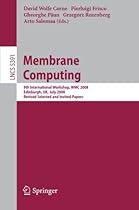Membrane Computing: 9th International Workshop, WMC 2008, Edinburgh, UK, July 28-31, 2008, Revised Selected and Invited Papers (Lecture Notes in Computer Science)

| Author | : | |
| Rating | : | 4.16 (537 Votes) |
| Asin | : | 3540958843 |
| Format Type | : | paperback |
| Number of Pages | : | 403 Pages |
| Publish Date | : | 2015-03-13 |
| Language | : | English |
DESCRIPTION:
This volume contains a selection of papers presented at the 9th Workshop on Membrane Computing, WMC9, which took place in Edinburgh, UK, during July 28–31,2008. The next ?ve workshops were organized in Tarragona, Spain, in July 2003, in Milan, Italy, in June 2004, in Vienna, Austria, in July 2005, in Leiden, The Netherlands, in July 2006, and in Thessaloniki, Greece, in June 2007, with the proceedings published as volumes 2933, 3365, 3850, 4361, and 4860 of Lecture Notes in Computer Science.. The ?rst three workshopson membrane computing were or- nized in Curtea de Arge¸ s, Romania – they took place in August 2000 (with the proceedings published in Lecture Notes in Computer Science, volume 2235), in August 2001 (with a selection of papers published as a special issue of Fun- menta Informaticae, volume 49, numbers 1–3, 2002), and in August 2002 (with the proceedings published in Lecture Notes in Computer Science, volume 2597)
An extremely detailed overview Beginning with neural networks almost half a century ago, bio-inspired computing has come a long way. This progress has been mostly in theoretical developments, but recently there has been an upsurge in practical applications, due mainly to the increase in computing power. This book gives an overview of a very interesting twist on bio-inspired computing, namely that of constructing a computational grammar b. Amazon Customer said First of its kind on Membrane Computing!!!. A innovative book that introduces the concepts of membrane computing, an alternative way of computation that mimics the structure and functioning of living cells. This is a new branch of computing, and though the concepts are well developed by Prof Paun (whom I have the honor of meeting in person), much work still remains to be done to bring the concepts into practical applications. Should make an interesti
… the book introduces complexity classes of problems that are suitable for membrane systems. … The book has extensive references, open problems and many ideas for further development." (Natasha Jonoska, Zentralblatt MATH, Vol. 1034, 2004). It also provides many open problems in such membrane complexity theory. From the reviews:"The subject of this book is the new computing model known as P-systems (honoring the initiator of the model who is the author of this book) and also as membrane systems
